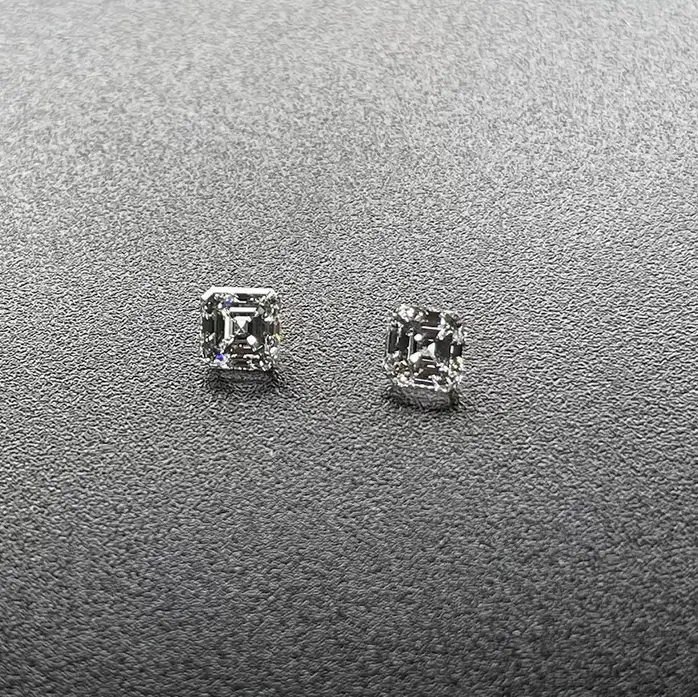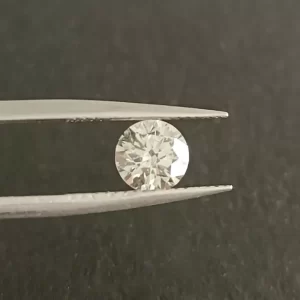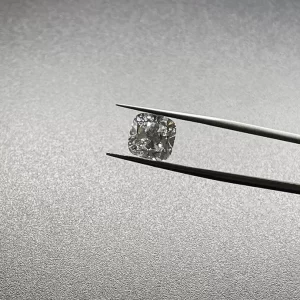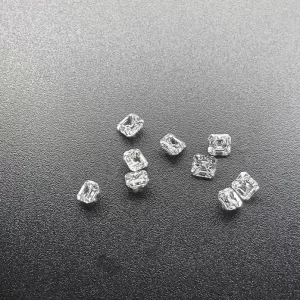White Certificated Lab Grown Fancy Cut Diamonds 0.30ct Plus
White Color Certificated Lab Grown Fancy Cut Diamonds For Making Lab Diamond Rings And Earrings
Fancy Cut Lab Diamonds Description
Lab diamonds are real diamonds. Carbon is the main element of natural and laboratory-grown diamonds. The chemical and physical properties of synthetic diamonds are same as natural diamonds in terms of hardness, thermal conductivity, and strength. After polishing it’s difficult to distingush lab diamonds and natural diamond by naked eyes.
Round diamonds are by far the most common and popular diamond shape. It also gives people more flexibility in balancing cutting, color and clarity. Its fire is beautiful and diverse, which is the most attractive. Brilliant cutting reflects most of the light. It is also known as the most brilliant and colorful cutting method. Round brilliant cut diamonds have 58 facets.
What is fancy cut diamond? The fancy shape diamond is a diamond with special cutting and maximization of rough diamond use compared with the traditional round diamond. Generally speaking, diamonds that are not round are shaped diamonds. the common fancy shape lab diamonds include pear shape, marquise shape, princess shape, radiant shape, emerald cut, heart shaple, oval shape, etc.
The cutting grade of a round diamond can be comprehensively judged by cut, symmetry and polish. When the three standards of a diamond are perfect, the cutting grade of the diamond is 3ex. However, there are only symmetry and polish criteria for fancy shaped diamonds, and even the best shaped diamond can only achieve 2ex cutting. Fancy shaped diamond is not as highly symmetrical as round diamond, and the cutting data standard is more unified, which can get the mechanical data that can judge the pros and cons.
Certificated Lab Grown Fancy Cut Diamonds
A certified lab-grown diamond has many benefits. Aside from its high quality and beauty, a certified diamond is more affordable than natural diamonds. And while GIA and IGI certification are the most widely recognized and trusted sources of lab-grown diamonds, other companies also offer these products. Among them are Brilliant Earth and HPHT. Read on to find out more about their certification processes. Then you can make an informed decision about your next diamond purchase.
GIA certification
GIA has been grading lab grown diamonds since 2007. However, these reports have not been the same as those for mined diamonds. Before, these reports consisted of the color range of the diamond, which was determined by its grading laboratory. This was often from an independent lab such as the IGI or GCAL. This has all changed, though, because GIA has now expanded its grading service to include lab grown diamonds in its catalog.
Until recently, GIA only graded mined diamonds. But, thanks to the GIA’s growing popularity, the organization has made small steps towards embracing lab grown diamonds. This will occur in Summer 2020. The move will validate the lab-grown diamond industry, while helping consumers better understand the difference between mined and lab-grown diamonds. This decision will also make GIA grading more consistent, since the report will use the same scale and grading methodology for both kinds of diamonds.
In addition to the grading report, the certificate will state the diamond’s carat weight, table percentage, and clarity. While the GIA does not assign cut grades to fancy cut diamonds, a high table percentage is necessary for a sparkling diamond. In addition, the report will detail the method of manufacturing the diamond, its color and clarity, and its inclusions. The GIA QR code can help you learn more about lab grown diamonds.
While GIA does do certification of lab-grown diamonds, the majority of these gems will likely be IGI certified. GIA reports are generally more expensive than those from other labs, so most sellers will opt for IGI certification. GIA is still the most reputable lab for grading lab-grown diamonds. So, what should you look for when shopping for diamonds?
HPHT
If you want to buy a fancy cut diamond but cannot afford a large amount, certificated lab grown versions are an excellent choice. The process to grow these diamonds in a lab is very similar to that of natural diamonds. Nevertheless, one advantage of lab grown diamonds is the lower price. You can save up to 20 to 30 percent on a diamond of the same carat size from the Brilliant Earth website. The website has around 800 lab grown diamonds that are available in different shapes and carat sizes.
When buying a certificated lab-grown diamond, you will need to take a look at the facets and the cut. The cut of the stone will have a large influence on its color and clarity. Gem shapes are chosen partly to hide flaws. Because of this, some lab-grown diamonds have poor color or large inclusions. In addition, if the stone has a yellow tint, an emerald cut would be a poor choice because it reveals everything in the stone. Lab diamonds with brilliant cuts are much more flaw-friendly.
There are various gemological laboratories around the world. Generally, they describe precious stones differently, resulting in substantial differences in grade. Therefore, it is important to know which lab to trust when buying certificated lab grown fancy cut diamonds. The IGI and GIA are the leading gemological labs in the industry. They use a strict process to grade lab-grown diamonds. GIA diamonds are certified as being of superior quality, but Ada Diamonds rejects ugly diamonds.
The clarity of a lab-grown diamond is determined by the visibility of imperfections. Expert gemologists grade the diamond’s clarity using a x10 magnification. The clarity scale runs from “I” (included) to “FL” (flawless), and natural diamonds have some inclusions similar to the ones in lab-grown diamonds. The clarity grade also indicates how much the diamond is damaged, so you can determine how much damage the diamond has taken in the process of growing it.
CVD
A CVD lab grown diamond is a real gem, just like any other. It is completely unique, and has the same chemical composition and structure as an ordinary diamond. The difference lies in the manufacturing process. A CVD lab grown diamond is a green, conflict-free product, and does not require the destruction of natural habitats. In addition, it is significantly cheaper than its natural counterpart. In terms of price, it is a better option for those on a budget.
Although lab grown diamonds are cheaper than natural diamonds, they don’t retain the resale value. In fact, most of them cannot be sold or resold. On the other hand, natural diamonds can be resold for a portion of their purchase price. So if you’re looking for a diamond with a high resale value, opt for a CVD certificated lab grown one.
When buying a lab-grown diamond, make sure to find out its grading report from a reputable laboratory. You can also compare the properties of the diamond against those of a natural diamond. Online retailers like James Allen, Ritani, and With Clarity will give you detailed information about the diamonds’ properties. They may also provide pictures of the stones. By using the certificates from a reputable laboratory, you’ll be assured of a diamond’s quality.
A CVD certified lab grown diamond should be cheaper than a natural diamond. Natural diamonds are twice as expensive as lab grown diamonds. If they’re listed at similar prices, chances are they’re fake. In fact, the prices of CVD certificated diamonds should be significantly lower than natural diamonds. However, if they’re selling at the same price as a natural diamond, they’re most likely scams.
IGI certification
The IGI is the world’s leading gemological institute, grading more gemstones than any other institute. With 14 schools of gemology and 14 laboratories worldwide, IGI has earned ISO 17025 certification for both natural and lab grown diamonds. The IGI reports diamond carat weight to two decimal places, while the GIA grades to three. In addition to this, IGI also seals diamonds to protect them from damage.
The certification describes the diamond’s material, shape, and symmetry. It also tells you how it was cut, and the proportions of its facetted facets. Using this certificate, you can confidently purchase a diamond that meets the highest standards of quality and value. Aside from a diamond’s color, IGI also provides a cut grade. For round brilliant diamonds, this grading system is available for fancy cut diamonds in the D-Z color range.
While the GIA has begun lab grown diamond certification, most of these stones will ultimately be IGI-certified. A GIA report is more expensive than other lab certifications, and most sellers will prefer to pay the IGI fee. The IGI certificate is still the gold standard for lab-grown diamonds, making it a highly reputable choice for buyers. There are several benefits to IGI certification for fancy cut diamonds.
Unlike a diamond appraisal, a grading report analyzes and plots the diamond’s unique characteristics. It also provides valuable information, such as the stone’s inclusions and treatment history. This information is invaluable to both buyers and sellers, and can give you peace of mind. The IGI certification for fancy cut diamonds is a trusted seal of quality. When purchasing a diamond, ensure that the certificate is authentic and accurate. If the certification is not accurate, you’ll likely end up overpaying for it, which is not a desirable outcome for any buyer.
GIA extensive report
The GIA offers two different types of reports when it comes to certificated lab grown diamonds. One is the “dossier,” which is a short report without the full clarity plot. These are commonly issued for small stones. The other type is called the “full grading report,” and it contains all the information a professional dealer needs to determine a diamond’s quality without physically seeing it.
GIA screens all stones to determine their origin and treatment. This particular diamond was grown with a HPHT process, and the DiamondView machine detected that it wasn’t a natural diamond. GIA researchers also noted that the font used for the diamond’s inscription was different from normal. These differences were enough to make the GIA issue a report separating the two types of stones.
The diamond’s faceting style and length are noted on the plot, as are the size and type of inclusions. The GIA also provides a chart showing the four C’s grading scales, which are used in judging the cut grade of diamonds. You can check the GIA report on the web by entering the report number. These reports are available free of charge, and you can check the authenticity of any given diamond by visiting its website.
Another way to differentiate between lab-grown and natural diamonds is the grade of certification. Although GIA does not certify lab-grown diamonds, many retail chains have partnered with the lab to offer a quality, legitimate gem. For consumers, a GIA certification is an additional level of assurance and peace of mind when purchasing a diamond. A legal jewelry vendor will always have a certificate on hand for the diamonds it sells.
White Certificated Lab Grown Fancy Cut Diamonds 0.30ct Plus

















